
CoinWeek Ancient Coin Series by Mike Markowitz …..
MUSIC IS MUCH older than civilization — it may be as old as language itself. The earliest known musical instrument, a flute made from a bear’s shinbone found in 1995 in a cave in Slovenia, dates from 43,000 years ago[1]. In the ancient world, musical instruments played important roles in worship and warfare as well as entertainment, and we see them depicted on a wide range of coins. In modern times, one of the most popular collectible bullion coins is the “Vienna Philharmonic” (Wiener Philharmoniker) issued since 1989 by the Austrian Mint. The reverse bears a horn, bassoon, harp, and four violins centered around a cello.
Lyre
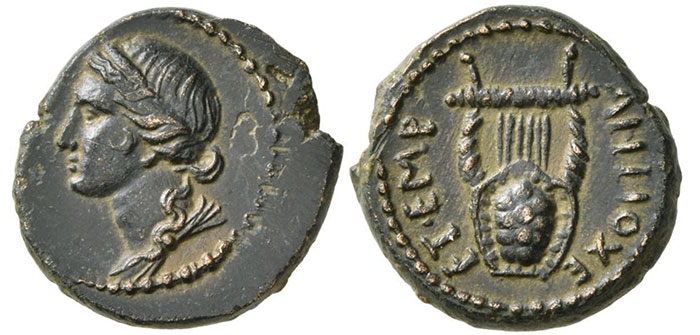
By far the most common musical instrument seen on ancient coins is the lyre, a kind of harp with a hollow soundbox, two curved arms, a crossbar, and between three to 12 gut strings that were strummed or plucked with a pick (plectrum). Seven strings were common. The second-century astronomer Claudius Ptolemy even put one in the northern sky, the constellation Lyra[2].
According to myth, the god Hermes fashioned the soundbox of the first lyre from the shell of a tortoise[3]. A detailed example of such a six-stringed tortoiseshell lyre, or chelys, appears on an elegant small bronze of Antioch in Syria dated to 96-97 BCE[4].
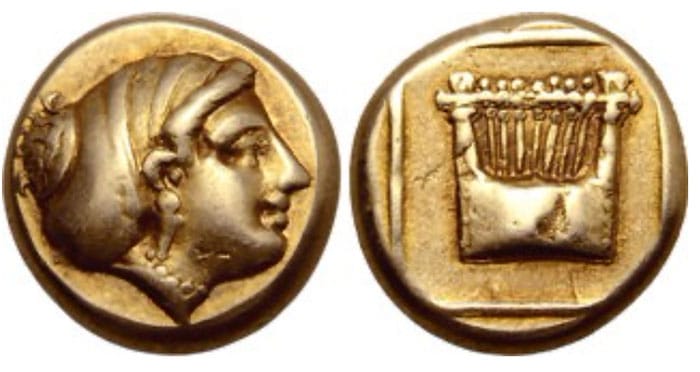
For the Greeks, music was the special province of both the god Apollo and the nine Muses, daughters of Zeus. On the reverse of an electrum hekte of Mytilene on the island of Lesbos, dated c. 412-378 BCE, we see a seven-stringed lyre[5]. The female figure on the obverse is identified as one of the Muses. At least three of the nine muses are depicted with lyres on coins: Calliope (epic poetry), Terpsichore (dance), and Erato (erotic poetry). But the female figure might also be the most famous daughter of Lesbos, the lyric poet Sappho (c. 630-570 BCE).

A large, wooden version of the lyre used by professional musicians was known as a cithara (or kithara). It was the emblem of the Chalkidian League, a group of cities in northern Greece. A richly decorated version appears on a silver tetradrachm of Olynthus, c. 410-401 BCE[6].

As the god of music, Apollo was particularly associated with this instrument, appearing as Apollo Citharoedus (“Apollo the cithara player”) on an elegant gold aureus of the first Roman emperor Augustus dated to 11-10 BCE[7].

People who know nothing else about the emperor Nero may recall that he “fiddled while Rome burned.” Actually, the instrument that Nero is said to have played mournfully during the Great Fire of 64 CE was a cithara. On the reverse of a remarkable bronze as (a coin of 7.75 grams,) Nero appears in the guise of the god, walking while playing the cithara[8].
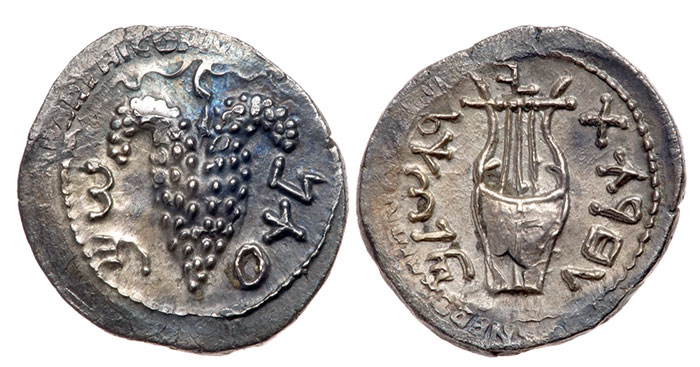
The ancient Hebrews used a three-stringed lyre (kinnor[9]). The term appears 42 times in the Old Testament. On a Judaean silver zuz of the “Bar Kochba Revolt” (132 – 135 CE), overstruck on a Roman denarius, the instrument is featured prominently as a symbol[10].
A stylized lyre appears on the modern Israeli half-shekel coin. The image was based on an ancient seal stone that some archaeologists now believe is a modern fake[11].
Flute
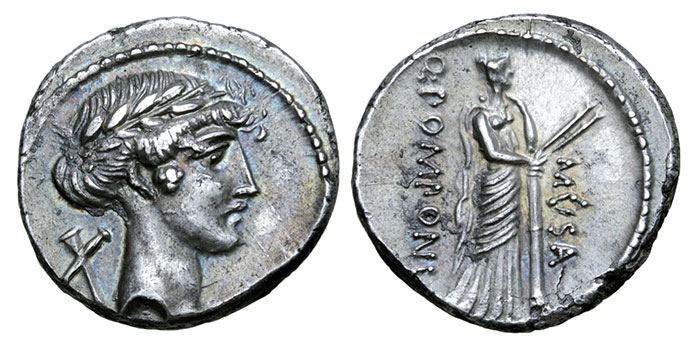
The double flute (aulos in Greek; tibia in Latin[12]) was used to accompany the recitation of poetry at elegant dinner parties. The shrill, piercing notes of the flute set the pace for rowers on warships and warriors in combat because the sound could be heard clearly over the clatter of oars or the din of battle. The father of Queen Cleopatra, Ptolemy XI, was nicknamed Auletes (“the flute player”) because of his proficiency with the instrument. The double flute was the special attribute of Euterpe, the muse of lyric poetry. She holds this instrument on a lovely denarius[13] of Pomponius Musa (66 BCE). Two small crossed flutes appear beside the head of Apollo on the coin’s obverse.
Pan Pipes
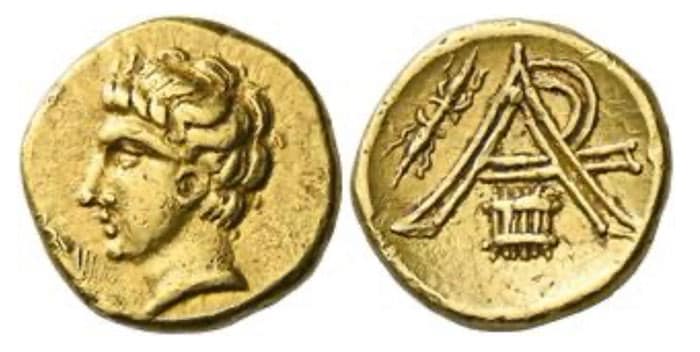
According to myth, the syrinx or “Pan pipes” was name for Syrinx[14], a nymph who was turned into a reed when she fled from the unwanted affections of the god Pan. Pan cut the reed and fashioned it into a set of pipes. The syrinx was a popular folk instrument, often associated with shepherds. It was used as an emblem by the Arkadian League, a group of southern Greek cities. On a unique gold quarter stater (c. 320-275 BCE) of Megalopolis, the league’s capital, the set of six pipes bound together appears below the league’s bold AR monogram[15].
Trumpet

Modern trumpets are usually made of brass (an alloy of copper and zinc), but the ancient trumpet (salpinx in Greek; usually tuba in Latin) was probably bronze. Trumpet players accompanied armies into battle. An early coin example is an electrum stater[16] of Cyzicus, depicting a helmeted naked warrior blowing a trumpet; on most surviving examples, the flared bell of the instrument is off of the coin’s edge.

A pair of silver trumpets were used in the worship service of the Temple in Jerusalem. Captured as booty by the Romans in 70 CE, they appear on the triumphal sculpture of the Arch of Titus in Rome. These lost relics were commemorated 64 years later on a silver coin[17] of the Bar Kochba Revolt, shortened to fit the available space.
Carnyx
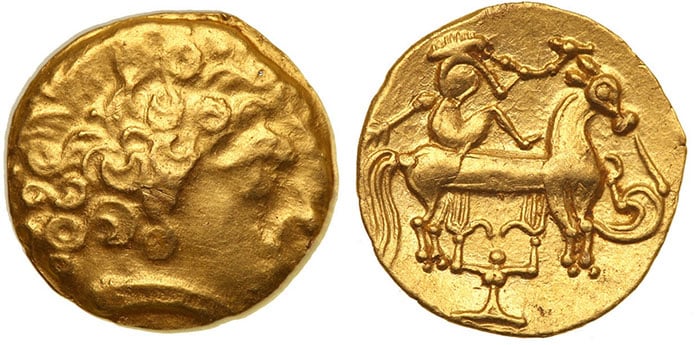
A bronze war trumpet used by Celtic tribes in Gaul, the carnyx was a long tube that terminated in the hollow head of a boar or dragon. A few examples have been found by archaeologists, and playable replicas have been made, so we know how it sounded.
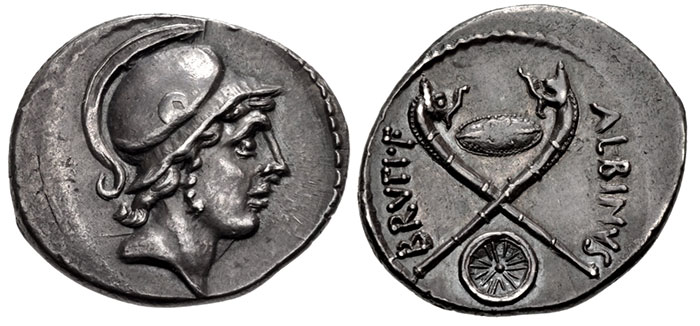
On the reverse of a rare Gaulish gold stater dated to the third or early second century BCE, we see a horseman playing the instrument[18]. The carnyx became an important trophy for the Romans. On coins, it appears as a symbol of victory over Gauls. One of the clearest examples is a silver denarius of 48 BCE, showing two of the instruments crossed[19].
Sistrum
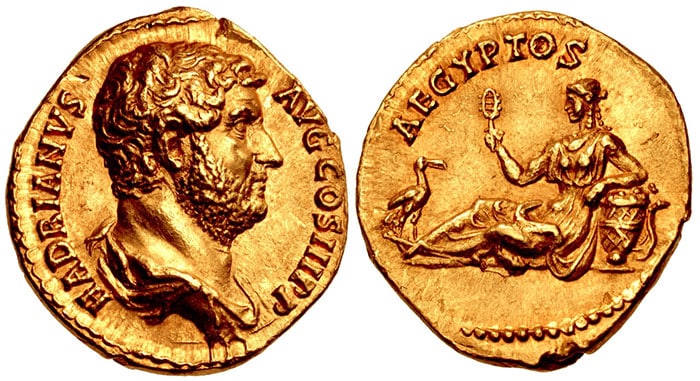
A metallic rattle used in worship by Egyptian priests, the sistrum[20] became a recognizable symbol of Egypt for Romans. A spectacular example is a gold aureus of the famous “Travel Series” of Emperor Hadrian. On the reverse, the reclining female personification of “Aegyptos” holds a sistrum. In a 2017 New York auction, this coin realized $128,500 USD against an estimate of $75,000[21].
A sistrum appears beside the ornate crown of the goddess Isis on a silver denarius of Juba II, Roman client king of Mauretania in North Africa. Juba married Cleopatra Selene, the daughter of famed Egyptian queen Cleopatra and the Roman Mark Antony[22].
Drum
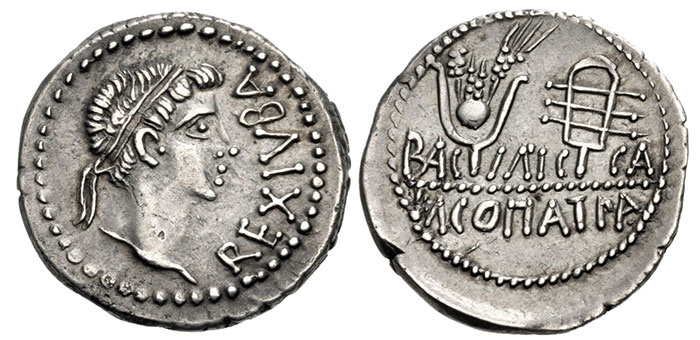

The tympanum was a kind of drum made from an animal skin stretched over a wooden hoop. It was often depicted on images of the Eastern goddess Cybele[23]. Riding in a chariot drawn by lions, Cybele was a goddess of exuberant fertility, ecstatic intoxication, and wild music (“sex, drugs, and rock and roll”). To the Romans, she was Magna Mater (“Great Mother”). On a Roman bronze sestertius[24] of Faustina “the Younger” (daughter of Antoninus Pius and wife of Marcus Aurelius) dated to c. 170 CE, we see Cybele enthroned, resting her right hand on a round tympanum.
* * *
Notes
[1] https://en.wikipedia.org/wiki/Divje_Babe_flute
[2] Vega, the brightest star in Lyra is one of the brightest visible stars.
[3] https://en.wikipedia.org/wiki/Chelys
[4] Leu Numismatics Web Auction 1, June 25, 2017, Lot 822. Realized CHF 380 (about $392 USD; estimate CHF 75).
[5] Roma Numismatics Auction XIX, March 26, 2020, Lot 463. Realized £400 (about $485 USD; estimate £300).
[6] NAC Auction 123, May 9, 2021, Lot 192. Realized CHF 3,000 (about $3,303 USD; estimate CHF 1,500).
[7] Nomos obolos 18, February 21, 2021, Lot 530. Realized CHF 8,500 (about $9,471 USD; estimate CHF 2,000).
[8] NAC Auction 120, October 6, 2020, Lot 714. Realized CHF 2,750 (about $3,005 USD; estimate CHF 1,500).
[9] https://en.wikipedia.org/wiki/Kinnor
[10] Goldberg Auction 117, September 15, 2020, Lot 2169. Realized $2,700 USD (estimate $500).
[11] https://newrepublic.com/article/130814/israeli-national-symbol-fake
[12] Tibia is also the name of the larger bone in the lower leg of mammals. Many ancient flutes carved from this bone survive. Ancient wooden flutes survive mainly from Egypt.
[13] Roma Numismatics Auction XX, October 29, 2020, Lot 430. Realized £800 (about $1,032 USD; estimate £1,250).
[14] https://en.wikipedia.org/wiki/Syrinx
[15] NAC Auction 124, June 23, 2021, Lot 172. Realized CHF 40,000 (about $43,455 USD; estimate CHF 50,000).
[16] Nomos Auction 13, October 7, 2016, Lot 205. Realized CHF 12,000 (about $12,250 USD; estimate CHF 15,000).
[17] Goldberg Auction 98, June 6, 2017, Lot 1646. Realized $1,600 USD (estimate $700-$800).
[18] Goldberg Auction 84, January 27, 2015, Lot 3000. Realized $11,500 USD (estimate $15,000-$20,000).
[19] CNG Triton XXIII, January 14, 2020, Lot 601. Realized $1,500 USD (estimate $500).
[20] https://en.wikipedia.org/wiki/Sistrum
[21] CNG Triton XX, January 10, 2017, Lot 734. Realized $128,500 USD (estimate $75,000).
[22] CNG Triton XXIV, January 19, 2021, Lot 827. Realized $1,400 USD (estimate $500).
[23] https://en.wikipedia.org/wiki/Cybele
[24] Numismatic Naumann Auction 80, August 4, 2019, Lot 565. Realized €400 (about $444 USD; estimate €160).
References
Anderson, Warren. Music and Musicians in Ancient Greece. Ithaca, NY (1994)
Martino, Amos. “Lyres representation on ancient Greek coins”, Proceedings XV International Numismatic Congress. Taormina (2015)
Terzes, Chrestos. “Musical Instruments of Greek and Roman Antiquity”, A Companion to Ancient Greek and Roman Music (T. Lynch and E. Rocconi, ed.). Hoboken, NJ. (2020)
* * *
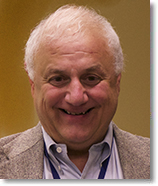 Mike Markowitz is a member of the Ancient Numismatic Society of Washington. He has been a serious collector of ancient coins since 1993. He is a wargame designer, historian, and defense analyst. He has degrees in History from the University of Rochester, New York and Social Ecology from the University of California, Irvine. Born in New York City, he lives in Fairfax, Virginia.
Mike Markowitz is a member of the Ancient Numismatic Society of Washington. He has been a serious collector of ancient coins since 1993. He is a wargame designer, historian, and defense analyst. He has degrees in History from the University of Rochester, New York and Social Ecology from the University of California, Irvine. Born in New York City, he lives in Fairfax, Virginia.




